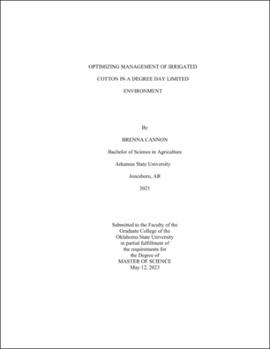| dc.contributor.advisor | Warren, Jason | |
| dc.contributor.author | Cannon, Brenna | |
| dc.date.accessioned | 2023-08-25T20:05:52Z | |
| dc.date.available | 2023-08-25T20:05:52Z | |
| dc.date.issued | 2023-05 | |
| dc.identifier.uri | https://hdl.handle.net/11244/338901 | |
| dc.description.abstract | The decline of the Ogallala Aquifer has jeopardized the future of agriculture in the states that it underlies. This has increased interest in growing crops with lower water requirements in the central Ogallala region, such as cotton. However, this region is challenged with low rainfall, limited growing degree days, and risk of early and late freezes. The objective of this study was to evaluate management systems to maximize profits and irrigate efficiency to maintain cotton quality. In the 2021 growing season, a trial was planted on the McCaull Research and Demonstration Farm near Eva, Oklahoma under a variable rate irrigation (VRI) equip pivot. The trial consisted of 19 treatments replicated 3 times. Treatments 2-7 were dictated by participants of the Testing Agriculture Performance Solutions (TAPS) program. Treatments 8-19 consisted of irrigation replacement based on evapotranspiration (ET) rates from the Oklahoma Mesonet, altered at various growth stages. This growing season was coupled with timely rainfalls and an extended growing season that reached yields of 2206 kg ha-1 in the full irrigation treatment with no detriment to fiber quality. Ceasing irrigation after squaring caused a significant decrease in lint yields and increasing irrigation in treatments of 40% of full during squaring to 70% of full or full irrigation allowed for recovery of lint yield compared to the constant 40% of full treatment in the short season variety, PHY205. In the TAPS studies, we observed a delay in maturity because of more irrigation. However, further data collection is necessary to draw definitive conclusions regarding the relationship between irrigation and delayed maturity in this environment. The results of this study demonstrate the importance of end-of-season irrigation and demonstrate how the management of various varieties can alter cotton growth and development. | |
| dc.format | application/pdf | |
| dc.language | en_US | |
| dc.rights | Copyright is held by the author who has granted the Oklahoma State University Library the non-exclusive right to share this material in its institutional repository. Contact Digital Library Services at lib-dls@okstate.edu or 405-744-9161 for the permission policy on the use, reproduction or distribution of this material. | |
| dc.title | Optimizing management of irrigated cotton in a degree day limited environment | |
| dc.contributor.committeeMember | Lofton, Josh | |
| dc.contributor.committeeMember | Sharma, Sumit | |
| osu.filename | Cannon_okstate_0664M_18052.pdf | |
| osu.accesstype | Open Access | |
| dc.type.genre | Thesis | |
| dc.type.material | Text | |
| dc.subject.keywords | cotton | |
| dc.subject.keywords | deficit | |
| dc.subject.keywords | irrigation | |
| dc.subject.keywords | NAWF | |
| dc.subject.keywords | Ogallala | |
| dc.subject.keywords | short season | |
| thesis.degree.discipline | Plant and Soil Sciences | |
| thesis.degree.grantor | Oklahoma State University | |
